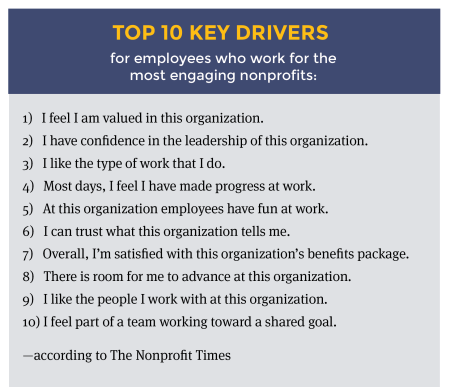
Note from Beth: In my book, The Happy Healthy Nonprofit: Strategies for Impact without Burnout, we discuss how to create a culture of wellbeing to encourage self-care. Jay Wilkinson, CEO of Firespring, shares some thoughts on building the right culture of for your nonprofit. I’ll be doing a free webinar hosted by Firespring on avoiding burnout on Feb. 14th. You can register here.
Guest Post: Your Nonprofit’s Culture: By Design or by Default? by Jay Wilkinson, Firespring CEO
When people hear the term “company culture,” they typically think “workplace perks”—those two are often confused or used interchangeably. At Firespring, we’ve created a fun environment with a pool table and shuffleboard in a space called the Firepit, free beer and soda in the break room and a huge slide in the middle of the building. It’s all pretty cool, to be honest. But those perks have nothing to do with our culture.
An organization’s culture is about people. It’s not about things or toys or cool stuff; it’s about people aligned with one another and focused on making an impact with shared goals and values.
Did you know that, according to the latest research, 70% of U.S. workers say they’re not engaged at work? 70%. When most people change jobs, it’s not to make more money—only 12% of employees cite financial reasons for job changes. According to Office Vibe, 75% of people voluntarily leaving jobs don’t quit their jobs; they quit their bosses.
We also know 70% of Millennials say they would take less money for an interesting job that is fun—so clearly, work is about more than just taking home a paycheck, especially for the youngest generation in the workforce. What does this mean for you? There’s value in creating an engaging, interesting and dynamic culture in your organization. It doesn’t have to cost you a fortune, but it does require strategy, thought and design. Great cultures do not happen by default.
At Firespring, we’ve built a vibrant culture that attracts top talent and passionate employees and have been able to sustain it for decades now. I won’t say it was easy or that it happened it overnight, but I will tell you, it wasn’t complicated. It took some soul searching, important discussions and time, but it basically involved these three steps:
1. We defined our values.
Many of us think we’ve already done this, but we haven’t been successful if our values don’t inspire us. Walt Disney once said, “Once your values are clear, decisions are easy.” In my experience, this is very true.
What I typically see in both for-profits and nonprofits alike are the same values, listed the same way. “We’re innovative. We’re team players. We strive for excellence. We have integrity. We are passionate.” You know what? Those are not values; they’re virtues. They’re all great, but they’re a little overused. In order for a value to stand out and be memorable, we need to state it in a way that resonates and allows people to live it out in a practical sense. At Firespring, we defined three specific values:
1. We bring it. Every day.
2. We have each other’s back.
3. We give a shit.
Excuse my language on the third one, but when we expressed it that way, people really rallied around it. They got it. You’d be amazed at how our team members have embraced these values because they make sense, they resonate and people can identify how to tangibly live them out. Which brings me to the second step.
2. We hire to our values.
Once you know your values, you can bring people on board who readily embrace them. At Firespring, we hire first for culture fit and second for skill set. In other words, we care way more about how they fit into our company than how skilled they are. Why? Because you can’t change people after you’ve hired them. You can train them, educate them, help them develop skills—but you can’t fundamentally change them.
3. We live our values.
This step comes down to one simple thing: repetition. Repetition is key to infusing your values into the fabric of your organization. At Firespring, we have a daily meeting we refer to as our Firestarter. For 11 minutes, at 11:11, we recap what’s happening in each department and recognize team members who live our values. “I want to give a shout-out to Julie who had my back the other day when I needed help with a client. She dropped everything and came to my rescue.” This is the type of thing you’d hear, every single day—people giving props to their coworkers for living our values in a tangible way.
Aligning with our “we give a shit” value, giving back to our community is a non-negotiable at Firespring. We require each team member to spend a portion of their work hours each month volunteering at a nonprofit. Last year, we collectively logged nearly 15,000 hours of volunteer time. This is a tangible way we live out our third value, and it’s (again) repetitive. We constantly look for opportunities to care more and give back; volunteering is never a one-and-done deal. It’s part of our fabric.
But enough about us. Let’s talk about you. You want to create a healthy, dynamic and attractive culture in your nonprofit, or you wouldn’t still be reading this. So where do you begin? I would suggest the following steps to get you on a path to the right culture for your organization.

1. Have a clear mission and vision. Your mission is like the soil you use to plant your garden—it’s your foundation. If you have soil that’s rocky and inconsistent, your efforts are going to be tenuous at best. If you don’t build your culture around a mission that’s inspiring and consistent, it will be hard to achieve unity in action. Before you worry about your organization’s culture, first be clear about your mission, if you’re not already.
2. Cultivate shared values. As I mentioned, your values dictate everyday action. “In our organization, a good person acts like [fill in the blank] and knows the importance of [fill in the blank].” Your job is to fill in those blanks and then make sure every person in your organization knows the answers. What is work/life balance? How long are people expected to be in the office? What’s your “working while on vacation” policy? Having difficult conversations and putting everything on the table is the healthiest thing an organization can do; that’s how you cultivate shared values. Once everyone is aligned, your values are like the sun and water for your garden (or culture)—they help it grow. If they’re not defined, your culture will never take root.
3. Put your people first. People always come first, period. Before policies and procedures. When we put people first, top talent comes out of the woodwork and flocks to our organization because they know they’ll be valued and treated with respect. Some questions to ask yourself about how your nonprofit treats people:
- How do we hire and fire people? If we have to let someone go, how do we embrace our values during that process?
- What behaviors do we reward? Are we giving people the opportunity to make mistakes without feeling bad? Do we admonish them or do we say, “Thank you for trying something new. Maybe next time we can try this, this or this.”
- Do we operate in silos? Or do we encourage open collaboration?
- Do we nurture personal growth? Or do we unknowingly quash people’s aspirations and dreams outside the workplace?
Here’s the bottom line: Most people in the U.S. spend more time at work than they do anywhere else. Why wouldn’t we want to create an environment and culture that feeds people with energy rather than sucking the life out of them? There are too many people who go to work every day thinking, “Man, I’d rather be anywhere else but here.”
It’s so important to create the type of culture that gets people excited about their jobs—that’s when you’ll see your organization take off and thrive. Just remember: Creating a dynamic culture is not a one-night stand; it’s an evolving process that requires consistent attention, care and evaluation. In the end, your efforts will be worth it. You’ll not only have improved the lives of your team members, but you’ll have furthered your positive impact on the world and advanced the cause you so passionately champion. That, after all, is what we’re here for.

Jay is the founder and CEO of Firespring—a company that provides beautiful websites and essential tools to nonprofit organizations.

Leave a Reply